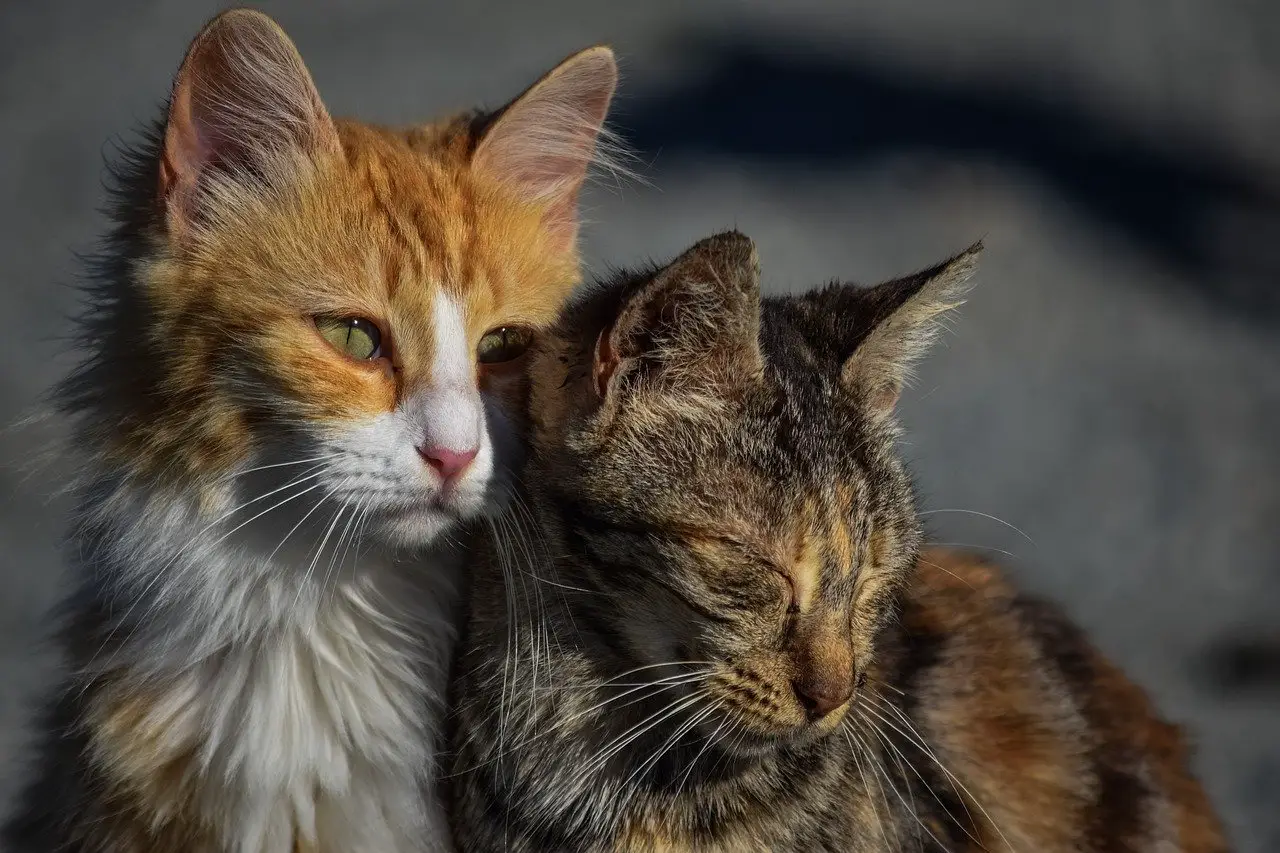Folks that own dogs and cats usually have a little bit of fear in the back of their mind that they are going to fight.
After all, we are all told from very young ages how much cats and dogs don’t mix. We’ve seen plenty of cartoons of dogs chasing after cats, usually getting themselves into all kinds of trouble along the way – with the cat almost always escaping and coming out on top.
And if you were to ask people that own both dogs and cats the majority of them would tell you to flat out that they are mostly worried about their dog attacking their poor, sweet, innocent little kitty.
Well, we can tell you quite confidently that sometimes the tables are turned 180° and it’s the cats that are causing all the mayhem!
This is especially true when you have a smaller sized dog, a dog that is close to (or even smaller than) the size of your cat. That’s when things can get really squirrelly.
If you’ve been dealing with trouble from cat attacks on your small dog and want to learn why they happen, how to prevent them, and (maybe most importantly) how to stop them dead in their tracks, you want to check out all the inside information we highlight below.
If you use the tips and tricks we include in this guide you’ll never again have to wonder how to stop my cat from attacking my small dog ever again!
Let’s dig right in.
How to Stop My Cat From Attacking My Small Dog
Better Understanding Feline Aggression
Truth be told, there are a whole bunch of reasons that your cat might be feeling a little frisky and want to jump your small dog every now and again.
Sometimes those behaviors are 100% linked to playful activity, with your cat only jumping and “attacking” your dog because it wants to play. Cats are notorious for springing traps on one another, for pouncing on one another, and for dashing in, batting another animal on the nose, and then dashing out again – even if we don’t see it done with a lot of dogs all the time.
On the other hand, though, sometimes these behaviors are linked directly to underlying feline aggression that you want to understand better to know what’s going on and how to stop it moving forward.
Sometimes cats feel cornered, scared, and particularly anxious and they aren’t shy about lashing out and attacking whatever it is that’s making them feel that way. If your dog is pretty playful and also likes to play roughly the chances are it could be scaring your cat every now and again, and the attacks are purely retaliatory.
Felines are also very territorial.
They like to mark their space, they like to lay claim to their territory (and “their people”), and they aren’t shy about reinforcing those boundaries whenever they feel like another animal is encroaching on them.
Cats have a similar hierarchal sort of society amongst themselves, with territorial alpha cats at the top of the totem pole. Believe it or not, in the tiny little body of your furry little family member beats the heart of a lion after all!
If they feel like your dog is messing around on their turf they may have to try and correct their behavior with a bit of force. You’ll know if this is happening when cats start to mark their territory, and you’ll really have all the proof you need to know this is what’s going on if your dog is counter marking and being aggressive, too.
How to Stop Your Cat from Attacking Your Small Dog in the Future
Because cats are so smart it really isn’t that challenging to break this kind of bad behavior, especially if you move in early and are very consistent with your corrections.
The worst thing you could do is sit on the sidelines and watch as these fights unfold, never really taking a stance and never establishing yourself as the ultimate alpha in this mixed family of pets and people and making sure that you lay down the law.
Thorough management should be priority number one.
What you basically want to do here is make sure that your animals always have an avenue of escape one another is feeling aggressive. Sometimes you can do this by getting physically in between the factions before they throw down, and other times you might do this with smart positioning of your furniture or other household items.
At the end of the day, it’s really about awareness (and using things like baby gates, cat stands, and window perches) to make sure that everyone has a way to abandon the fight before it kicks off.
If an animal that otherwise gets along well with another has an avenue of escape they are almost always going to take that rather than stand their ground and throw down.
Secondly, you’ll want to eliminate stressors as much as possible.
You might not be able to manage stress completely – especially if it’s your cat attacking your small dog because they are new to the home (with a new puppy, for example) – but you want to do as much as you can to normalize even, calm, and relaxed behaviors as quickly as possible.
Cats are (no surprise here) notoriously responsive and sensitive to even the smallest of changes.
Understand that, embrace that, and look for ways to eliminate stressors that are causing or triggering your cat to attack your dog to begin with.
Third, sometimes you have to understand that your cat has an internal “prey drive” instinct that’s going to almost physically compel them to mess around with your small dog.
Things might be able to progress while your puppy or dog remains small, but if the behavior starts to get out of line (or things start to get really aggressive) you need to interject and break things up as quickly as you can.
It’s a good idea if you can break the concentration of your cat on your small dog with another small prey item that they would have an easier time jumping. A tiny little mouse on a string, for example, will catch their attention pretty quickly, re-divert their focus entirely, and take care of their prey drive instincts all at the same time.
That’s a winning combination for sure.
Of course, you might have to do a bit of aggression redirection if things are really getting wild.
Cats can get excited by pretty much anything, including something that has absolutely nothing to do with your small dog, and they may be redirecting their focus and aggression on that tiny little animal just because he is in close proximity.
If you’re noticing your cat is starting to get a little wild it may not be a bad idea to move them into a safer space (maybe a darker room where they can sort of calm themselves down) so they can sort of resetting their focus.
This approach works wonders if you’re able to get a jump on things before it gets out of hand.
Finally, you may be dealing with simple incompatibility issues.
This can be the hardest challenge of all to deal with – particularly if you love both of these little furry family members equally.
Sometimes you can keep these animals separate and avoid the incompatibilities entirely, especially since cats are (by their very nature) pretty independent. Sometimes, though, it’s only going to work well if you rehome or re-house one of these animals.
That’s kind of the “nuclear option”, though as nobody wants to break up there for the family.
Stopping Cat Attacks in the Moment
Now that we have covered how to stop cat attacks in advance it’s not a bad idea to know how to stop these attacks as they unfold at the moment.
There are a couple of tactics you want to keep in your back pocket, none quite as effective as making a sudden (very loud) noise – like screeching, whistling, or banging pots and pans together.
This will immediately break the tension and usually kick the flight part of the “fight or flight” instincts of your animals into high gear, causing them both to run for the hills and to find cover.
You might also want to squirt some water (keep room temperature water in a clean spray bottle on hand for just these occasions) at both of these animals. Cats really (REALLY) hate water and this approach will dissuade them from these kinds of attacks faster than maybe anything short of the tip we mentioned above.
Finally, it might not be a bad idea to throw a blanket over one of the animals (ideally the cat on the warpath) to prevent them from doing any damage to the other animal. You can then safely and confidently move in to separate the animals, to give them their space, and to allow them to calm down.
The last thing you want to slide between these fights. It doesn’t take much to train them to redirect their aggression on you. Then you’ll have a whole host of other issues you have to deal with!
[su_box title=”Affiliate Disclosure”]This website is supported by its readers. Please assume that all links are affiliate links. If you make a purchase from one of the links we will make a commission from Amazon. Thank you.[/su_box]





